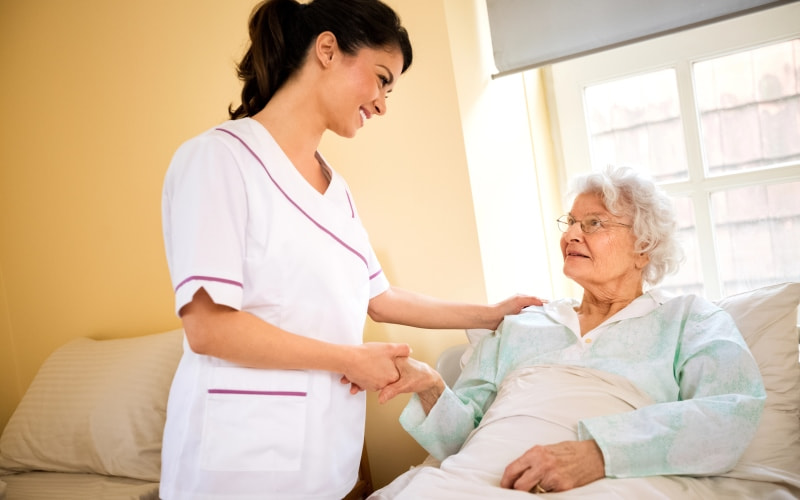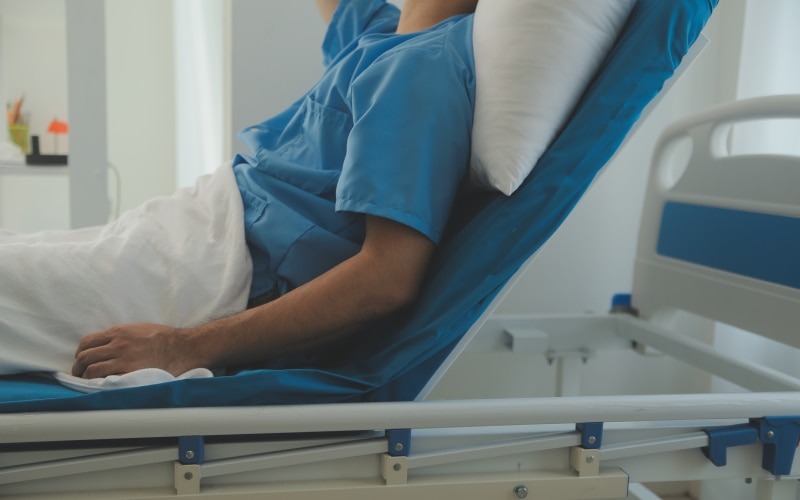Bedsores can appear in people of any age if they cannot independently change the position of the body. For example, they are bedridden or wheelchair-bound. Treatment and prevention of bedsores are a whole range of measures to care for a sick person. It is easier to prevent bedsores than to treat them.
The skin is an important organ, thanks to which the integrity of the human body is preserved, the constancy of the internal environment of the body. The skin consists of the epidermis and the skin itself: the dermis, which contains blood vessels, sebaceous and sweat glands, nerve endings. Oxygen enters through the skin, which mainly supplies the cells of the epidermis.
To protect the skin, it is necessary to maintain its purity, elasticity and continuous blood supply. If one or more of these conditions are not met, various skin diseases may occur. Bedsores are one of the most dangerous disorders of the normal functioning of the skin for human health.
Bedsores are areas of necrosis and ulceration that occur in places where soft tissues are squeezed between bone protrusions and hard surfaces.
Bedsores can appear in people of any age if they are bedridden or wheelchair-bound and cannot change their position on their own. Bedsores may occur from a plaster cast, splint, poorly fitted orthopedic prosthesis or from constant pressure on the skin of other hard objects.

How do bedsores occur
The main cause of bedsores in bedridden patients is an uneven distribution of pressure between the supporting areas of the body and the surface of the bed. The pressure in such areas of the body is higher than the pressure in the small vessels feeding the skin, about 10-15 mmHg. If the blood does not reach the skin for more than 2 hours, then there is a violation of nutrition (ischemia) of tissues, and then their necrosis. As a result, a bedsore develops.
At first, a pale spot appears on the skin, then this spot turns red and swells, sometimes accompanied by the formation of bubbles in the places of epidermis detachment. Then necrosis leads to the exposure of the wound surface and its further infection, damage to the underlying tissues, up to the bone. If unfavorable conditions persist, the area of bedsores quickly begins to grow, sometimes capturing almost all areas of the body in contact with the supporting surface.
Factors contributing to the formation of bedsores: immobility of the patient's body, a hard surface, contamination of the skin and underwear with urine and feces, careless manipulations leading to damage to the epidermis.
Risk factors for bedsores: reduced nutrition and lack of drinking, overweight, exhaustion, cardiovascular diseases, diabetes mellitus, sweating at elevated temperatures, allergic reactions to skin care products.
Bedsores can be life-threatening if patients do not receive appropriate treatment or underlying diseases prevent their healing.
Bedsores are especially dangerous for elderly and senile people. Many older people have less fat and muscle, which help absorb pressure. The number of blood vessels is reduced, and their walls become thinner and tear more easily. All wounds, including bedsores, heal more slowly.
Certain conditions contribute to the development of pressure sores in the elderly:
- Inability to move normally due to illness, for example, stroke.
- The need to stay in bed for a long time, for example, due to surgery.
- Excessive drowsiness. Such people rarely change their position or rarely ask someone to help them with this.
- Loss of sensitivity due to nerve damage. Such people do not feel discomfort or pain that would prompt them to change their position.
- A weak reaction to one's own discomfort or pain due to an illness, for example, dementia.
- Weak ability to heal wounds due to diseases such as diabetes mellitus, peripheral artery disease or venous insufficiency.
How to prevent bedsores
Treatment and prevention of bedsores are a whole range of measures to care for a sick person. It is easier to prevent bedsores than to treat them.
The best ways to prevent the formation of pressure sores are frequent changes of body position and careful skin care. Bedridden patients should be turned over every 2 hours. Caregivers should carefully examine the skin daily to see early signs of redness or discoloration. Any pigmentation that is not characteristic of normal skin signals that it is time to change the lying position. In addition, it is recommended to conduct a gentle massage of the surface tissues. This prevents stagnation of blood and lymph in the skin and subcutaneous fat.
The following simple rules of proper care for a bedridden patient will help not to provoke excessive skin friction that causes the appearance of bedsores:
- Do not pull up the patient alone.
- Do not pull out the sheets from under the patient, especially wet ones.
- Do not push the urinal under the patient, it is necessary to lift them first.
- It is not recommended to try to seat or give a semi-sitting position to weak patients. Their muscle activity is not enough to stay in this position, and they gradually begin to slide. Any device for foot support will prevent sliding.
To prevent bedsores, it is good to use anti-bedsore mattresses. Their design allows you to increase the area of the supporting surface of the skin by adjusting the pressure in the mattress depending on the weight of the patient. A regular, optimally once in 5 minutes, change of pressure in different parts of the mattress leads to a change of pressure in different areas of the skin in contact with the mattress.
Nutrition and drinking of bedridden patients
Bedridden patients are recommended by doctors to include more protein in the diet. Protein is a building material for muscles that can atrophy at rest. Choose food that contains a lot of micronutrients – iron, zinc, vitamin C. It is good if the patient's menu will include fermented dairy products, herbs, vegetables, fruits. For severe patients, it is better to replace meat with lighter sources of protein – chicken broth, fish, beans, cereals and dairy products. If there are no restrictions, then it is advisable to drink at least 1.5 liters per day. It is undesirable to use sweet and carbonated drinks, fast food.
Skin care for bedridden patients
- Lay soft linen for the patient, without rough seams, buttons, patches; regularly and often adjust the bed so that there are no folds and small objects under it.
- Regularly perform a perineal hygiene. Fecal and urine particles are strong irritants. Even if the patient has urinary incontinence, in no case limit their drinking. With a lack of fluid, the concentration of urine increases, and, accordingly, the intensity of irritation.
- Cut your nails short for yourself and the patient to avoid damage and scratching of the skin. With prolonged lying or sitting on the compressed areas, itching occurs. Make sure that the patient is dressed and covered with a blanket according to the temperature of the room. Overheating causes increased sweating and increases the risk of developing pressure sores.
 The skin care rules are quite simple:
The skin care rules are quite simple: avoid skin contamination, excessive dryness and humidity, since the bedridden patient's skin is easily exposed to the external factors.
The general rule: dry the wet skin and wet the dry skin. Carry out cleansing procedures without using the antibacterial soap. Along with harmful bacteria, soap also destroys beneficial microorganisms. After using such soap, the skin is barely able to resist even a minor infection. When washing the skin surface of compression places, use a soft sponge and wash with delicate movements, avoiding injury to the upper skin layers. To dry the skin after washing, gently pat dry it with a soft cotton cloth. Or you can use one of the following preparations: 1% potassium permanganate solution, brilliant green solution, zinc ointments. When applying zinc ointment, gauze bandages do not stick to the wound edges, and accordingly, do not injure the newly formed epithelium and granulations when removing the bandage.
When applying bandages to deep bedsores, dress the wounds to their full depth, but not tight.
Avoid massaging the reddened skin areas, but giving a light regular massage around these areas is highly recommended. Be sure to air bath the skin.
It is important to practise the patient hygiene: change underwear often. In case of involuntary urination, pads or special diapers will be very helpful, although for some patients it is enough to give the urinal more often. Instead of pads and diapers, you can use diapers made of underwear. Several times folded cotton underwear, laid in the crotch or placed under the buttocks, will limit the flow of urine, and old washed underwear absorbs moisture well.
Men's urinary incontinence is easier to cope with. You can use a special urination system.
Increased sweating occurs in patients with high fever. In order to reduce sweating, it is necessary, first of all, to treat the underlying disease. To wipe the patient, it is better to use not soap and water, but a weak vinegar solution: 1 tablespoon of table vinegar per 1 glass of water.
Principles of treatment of pressure sores
It is necessary to free the affected areas from compression so that blood can flow freely to the place of the formed bedsore.
Pressure sores arise from compression, and if it is weakened, then blood circulation at the site of injury will be restored. This will lead to the rejection of the formed necrosis (bedsore) and the gradual healing of the wound through granulation and epithelization.
To reject necrosis, mechanical removal of necrotic masses is used surgically or drugs are used that accelerate self-rejection.
To treat a wound, you need to clean it, then create conditions for healing. This can be done with alginates in the form of napkins and powder for filling wounds, hydrocolloid dressings that help to clean and close the wound. You can use a wide variety of healing ointments and gels.
Often secondary infections complicate the condition of the skin. In such cases, it is necessary to use antiseptic and antibacterial agents. In severe cases, for weakened and elderly patients, the intake of antibacterial drugs is contraindicated.
Sometimes poorly healing and large-area bedsores can be cured only surgically, by tissue transplantation.
Bandages are used in the treatment of bedsores. To fix the bandages, use a bandage or plaster. However, the patch tears off the top layer of skin cells when removed, which can provoke the appearance of new wounds. To avoid such complications, it is better to use a paper-based patch – the skin under it breathes well, and the adhesive base injures the skin less when removing the patch. When applying the patch, do not pull it hard to avoid the formation of small skin folds. Keep in mind that when the patient's position changes, the soft tissues will shift and stretch, which can lead to the formation of undesirable skin folds.
Treatment of bedsores at an early stage can be successful if the patient has received timely treatment. But it usually takes several weeks for a full recovery. After 6 months of treatment, more than 70% of stage II bedsores, 50% of stage III bedsores and 30% of stage IV bedsores heal.

